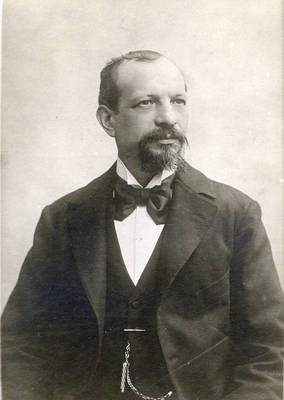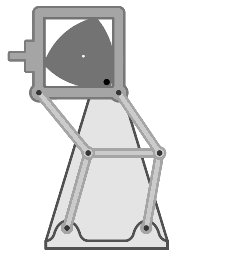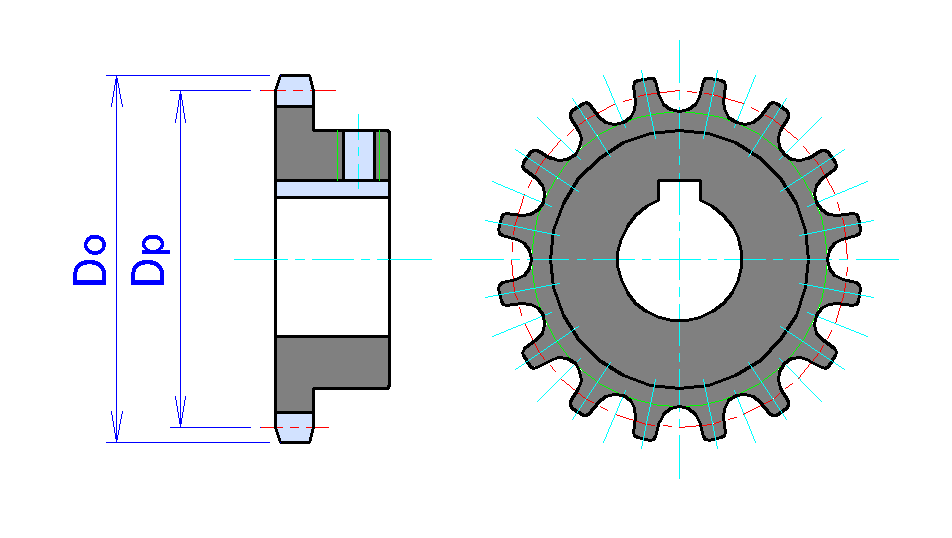|
Eidoloscope
The Eidoloscope was an early motion picture system created by Eugene Augustin Lauste, Woodville Latham and his two sons through their business, the Lambda Company, in New York City in 1894 and 1895. The Eidoloscope was demonstrated for members of the press on April 21, 1895, and opened to the paying public on Broadway on May 20. History Originally called the Pantoptikon (also spelled 'Panoptikon'), it is perhaps the first widescreen film format, with an aspect ratio (image), aspect ratio of 1.85 to 1. It had a film gauge of 51 mm and an aperture of 37 mm by 20 mm. It was instrumental in the history of film in that it created what became known as the "Latham loop", which are two loops of film, one on each side of the intermittent movement, which act as a buffer between continuously moving sprockets and the jerky motion of the intermittent movement. This relieved strain on the filmstrip and so enabled the shooting and projection of much longer motion pictures than had ... [...More Info...] [...Related Items...] OR: [Wikipedia] [Google] [Baidu] [Amazon] |
Kinetoscope
The Kinetoscope is an early motion picture exhibition device, designed for films to be viewed by one person at a time through a peephole viewer window. The Kinetoscope was not a movie projector, but it introduced the basic approach that would become the standard for all cinematic projection before the advent of video: it created the illusion of movement by conveying a strip of perforated film bearing sequential images over a light source with a high-speed shutter. First described in conceptual terms by U.S. inventor Thomas Edison in 1888, it was largely developed by his employee William Kennedy Laurie Dickson between 1889 and 1892. Dickson and his team at the Edison lab in New Jersey also devised the Kinetograph, an innovative motion picture camera with rapid intermittent, or stop-and-go, film movement, to photograph movies for in-house experiments and, eventually, commercial Kinetoscope presentations. A Kinetoscope prototype was first semipublicly demonstrated to members ... [...More Info...] [...Related Items...] OR: [Wikipedia] [Google] [Baidu] [Amazon] |
Eugene Augustin Lauste
Eugène Augustin Lauste (17 January 1857 in Montmartre, France – 27 June 1935 in Montclair, New Jersey) was a French inventor instrumental in the technological development of the history of cinema. Life By age 23 Lauste had filed 53 French patents. He emigrated to the United States in 1886 and started working at the Edison Laboratories where he met French-born William Kennedy Laurie Dickson. Lauste occasionally contributed to the development of the leading predecessor to the motion picture projector, the Kinetoscope, though he was never Dickson's chief assistant. Lauste left Edison in 1892. Lauste also worked on an idea for a combustible gasoline engine; he did develop a working model in the 1890s but gave up when told that such a noisy device would never be widely used. He then worked with Major Woodville Latham, for whom he engineered the Eidoloscope and assisted with the design of the Latham loop. (Later, Dickson would credit Lauste with the loop's invention.) The Eidolos ... [...More Info...] [...Related Items...] OR: [Wikipedia] [Google] [Baidu] [Amazon] |
Motion Picture
A film, also known as a movie or motion picture, is a work of visual art that simulates experiences and otherwise communicates ideas, stories, perceptions, emotions, or atmosphere through the use of moving images that are generally, since the 1930s, synchronized with sound and (less commonly) other sensory stimulations. Etymology and alternative terms The name "film" originally referred to the thin layer of photochemical emulsion on the celluloid strip that used to be the actual medium for recording and displaying motion pictures. Many other terms exist for an individual motion-picture, including "picture", "picture show", "moving picture", "photoplay", and "flick". The most common term in the United States is "movie", while in Europe, "film" is preferred. Archaic terms include "animated pictures" and "animated photography". "Flick" is, in general a slang term, first recorded in 1926. It originates in the verb flicker, owing to the flickering appearance of early films. ... [...More Info...] [...Related Items...] OR: [Wikipedia] [Google] [Baidu] [Amazon] |
Woodville Latham
Major Woodville Latham (1837–1911) was an ordnance officer of the Confederacy during the American Civil War and professor of chemistry at West Virginia University. He was significant in the development of early film technology. Woodville Latham was the father of Grey Latham and Otway Latham, owners of a kinetoscope parlor in New York City. In December 1894 Latham and his two sons formed the Lambda Company at 35 Frankfort Street, employing Eugène Lauste, a former Thomas Edison employee, as well as motion picture pioneer William Kennedy Dickson. Dickson would not leave Edison's employ until April 1895 and initially lent his expertise to the Lathams in secret. The Eidoloscope was demonstrated for members of the press on April 21, 1895, and opened to the paying public on May 20, in a lower Broadway store with films of the Griffo-Barnett prize boxing fight, taken from Madison Square Garden's roof on May 4. In 1898 the Lathams abandoned motion pictures and soon lost their paten ... [...More Info...] [...Related Items...] OR: [Wikipedia] [Google] [Baidu] [Amazon] |
William Kennedy Laurie Dickson
William Kennedy Laurie Dickson (3 August 1860 – 28 September 1935) was a British- American inventor who devised an early motion picture camera under the employment of Thomas Edison. Early life William Kennedy Dickson was born on 3 August 1860 in Le Minihic-sur-Rance, Brittany, France. His mother, Elizabeth Kennedy-Laurie (1823–1879) was American, born in Virginia. His father was James Waite Dickson, a Scottish artist, astronomer and linguist. James Dickson claimed direct lineage from the painter William Hogarth, and from Judge John Waite, the man who sentenced King Charles I to death. Inventor and film innovator At age 19 in 1879, William Dickson wrote a letter to American inventor and entrepreneur Thomas Edison seeking employment. He was turned down. That same year Dickson, his mother, and two sisters moved from Britain to Virginia. In 1883 he was finally hired to work at Edison's laboratory in Menlo Park, New Jersey. In 1888, Edison conceived of a device that wo ... [...More Info...] [...Related Items...] OR: [Wikipedia] [Google] [Baidu] [Amazon] |
List Of Film Formats
This list of motion picture film formats catalogues formats developed for shooting or viewing motion pictures, ranging from the Chronophotographe format from 1888, to mid-20th century formats such as the 1953 CinemaScope format, to more recent formats such as the 1992 IMAX HD format. To be included in this list, the formats must all have been used in the field or for test shooting, and they must all use photochemical images that are formed or projected on a film base, a transparent substrate which supports the photosensitive emulsion. As well, the formats must have been used to make more than just a few test frames. The camera must be fast enough (in frames per second) to create an illusion of motion consistent with the persistence of vision phenomenon. The format must be significantly unique from other listed formats in regard to its image capture or image projection. The format characteristics should be clearly definable in several listed parameters (e. g., film gauge, as ... [...More Info...] [...Related Items...] OR: [Wikipedia] [Google] [Baidu] [Amazon] |
New York City
New York, often called New York City (NYC), is the most populous city in the United States, located at the southern tip of New York State on one of the world's largest natural harbors. The city comprises five boroughs, each coextensive with a respective county. The city is the geographical and demographic center of both the Northeast megalopolis and the New York metropolitan area, the largest metropolitan area in the United States by both population and urban area. New York is a global center of finance and commerce, culture, technology, entertainment and media, academics, and scientific output, the arts and fashion, and, as home to the headquarters of the United Nations, international diplomacy. With an estimated population in 2024 of 8,478,072 distributed over , the city is the most densely populated major city in the United States. New York City has more than double the population of Los Angeles, the nation's second-most populous city. [...More Info...] [...Related Items...] OR: [Wikipedia] [Google] [Baidu] [Amazon] |
Widescreen
Widescreen images are displayed within a set of aspect ratio (image), aspect ratios (relationship of image width to height) used in film, television and computer screens. In film, a widescreen film is any film image with a width-to-height aspect ratio greater than 4:3 (1.33:1). For TV, the original screen ratio for broadcasts was in 4:3 (1.33:1). Largely between the 1990s and early 2000s, at varying paces in different countries, 16:9 (e.g. 1920×1080p 60p) widescreen displays came into increasingly common use by high-definition video, high definitions. With computer displays, aspect ratios other than 4:3 (e.g. 1920×1440) are also referred to as "widescreen". Widescreen computer displays were previously made in a 16:10 aspect ratio (e.g. 1920×1200), but nowadays they are 16:9 (e.g. 1920×1080, 2560×1440, 3840×2160). Film History Widescreen was first used for ''The Corbett-Fitzsimmons Fight'' (1897). This was not only the longest film that had been released to date at 10 ... [...More Info...] [...Related Items...] OR: [Wikipedia] [Google] [Baidu] [Amazon] |
Aspect Ratio (image)
The aspect ratio of an image is the ratio of its width to its height. It is expressed as two numbers separated by a colon, in the format width:height. Common aspect ratios are 1.85:1 and 2.39:1 in cinematography, 4:3 and 16:9 in television, and 3:2 in still photography and 1:1: Used for square images, often seen on social media platforms like Instagram, 21:9: An ultrawide aspect ratio popular for gaming and desktop monitors. Some common examples The common film aspect ratios used in cinemas are 1.85:1 and 2.39:1.The 2.39:1 ratio is commonly labeled 2.40:1, e.g., in the American Society of Cinematographers' ''American Cinematographer Manual'' (Many widescreen films before the 1970 Society of Motion Picture and Television Engineers, SMPTE revision used 2.35:1). Two common videography, videographic aspect ratios are 4:3 (1.:1), the universal video format of the 20th century, and 16:9 (1.:1), universal for high-definition television and European digital television. Other cinematic ... [...More Info...] [...Related Items...] OR: [Wikipedia] [Google] [Baidu] [Amazon] |
Latham Loop
The Latham Loop is used in film projection and image capture. It isolates the filmstrip from vibration and tension, allowing movies to be continuously shot and projected for extended periods. Invention of the Latham loop is usually credited to film pioneers William Kennedy Laurie Dickson and Eugene Lauste. Both men worked with Woodville Latham, developing a motion picture camera and projector in 1895. Dickson later acknowledged Lauste as inventor of the loop, though rival claims were made in support of another Latham associate, engineer Enoch J. Rector, who used the technology to shoot an hour-and-a-half-long documentary film, ''The Corbett-Fitzsimmons Fight'', in 1897. Woodville Latham applied for a patent on June 1, 1896. In his patent application, Latham wrote, :In order that these parts f the film projectormay operate as described, it is essential that the loop of slack film be maintained at all times ready for the intermittingly-acting device and also that the slack-mani ... [...More Info...] [...Related Items...] OR: [Wikipedia] [Google] [Baidu] [Amazon] |
Intermittent Movement
An intermittent mechanism or intermittent movement is a device or movement which regularly advances an object, web, or plastic film and then holds it in place. This process is commonly used in industry and manufacturing. This motion is critical to the use of film in a movie camera or movie projector. This is in contrast to a continuous mechanism, whereby the film is constantly in motion and the image is held steady by optical or electronic methods. The reason the intermittent mechanism "works" for the viewer is because of a phenomenon called persistence of vision. History Intermittent mechanisms were first used in sewing machines, in order for the fabric to be fed through correctly - ensuring it is stationary as each stitch is made, while moving the required distance between stitches. Methods used The intermittent mechanism must be employed in concert with a rotating shutter which blocks light transmittance during the motion of the film and allows light through while the ... [...More Info...] [...Related Items...] OR: [Wikipedia] [Google] [Baidu] [Amazon] |
Sprockets
A sprocket, sprocket-wheel or chainwheel is a profiled wheel with teeth that mesh with a chain, rack or other perforated or indented material. The name 'sprocket' applies generally to any wheel upon which radial projections engage a chain passing over it. It is distinguished from a gear in that sprockets are never meshed together directly, and differs from a pulley in that sprockets have teeth and pulleys are smooth except for timing pulleys used with toothed belts. Sprockets are used in bicycles, motorcycles, tracked vehicles, and other machinery either to transmit rotary motion between two shafts where gears are unsuitable or to impart linear motion to a track, tape etc. Perhaps the most common form of sprocket may be found in the bicycle, in which the pedal shaft carries a large sprocket-wheel, which drives a chain, which, in turn, drives a small sprocket on the axle of the rear wheel. Early automobiles were also largely driven by sprocket and chain mechanism, a practice larg ... [...More Info...] [...Related Items...] OR: [Wikipedia] [Google] [Baidu] [Amazon] |







